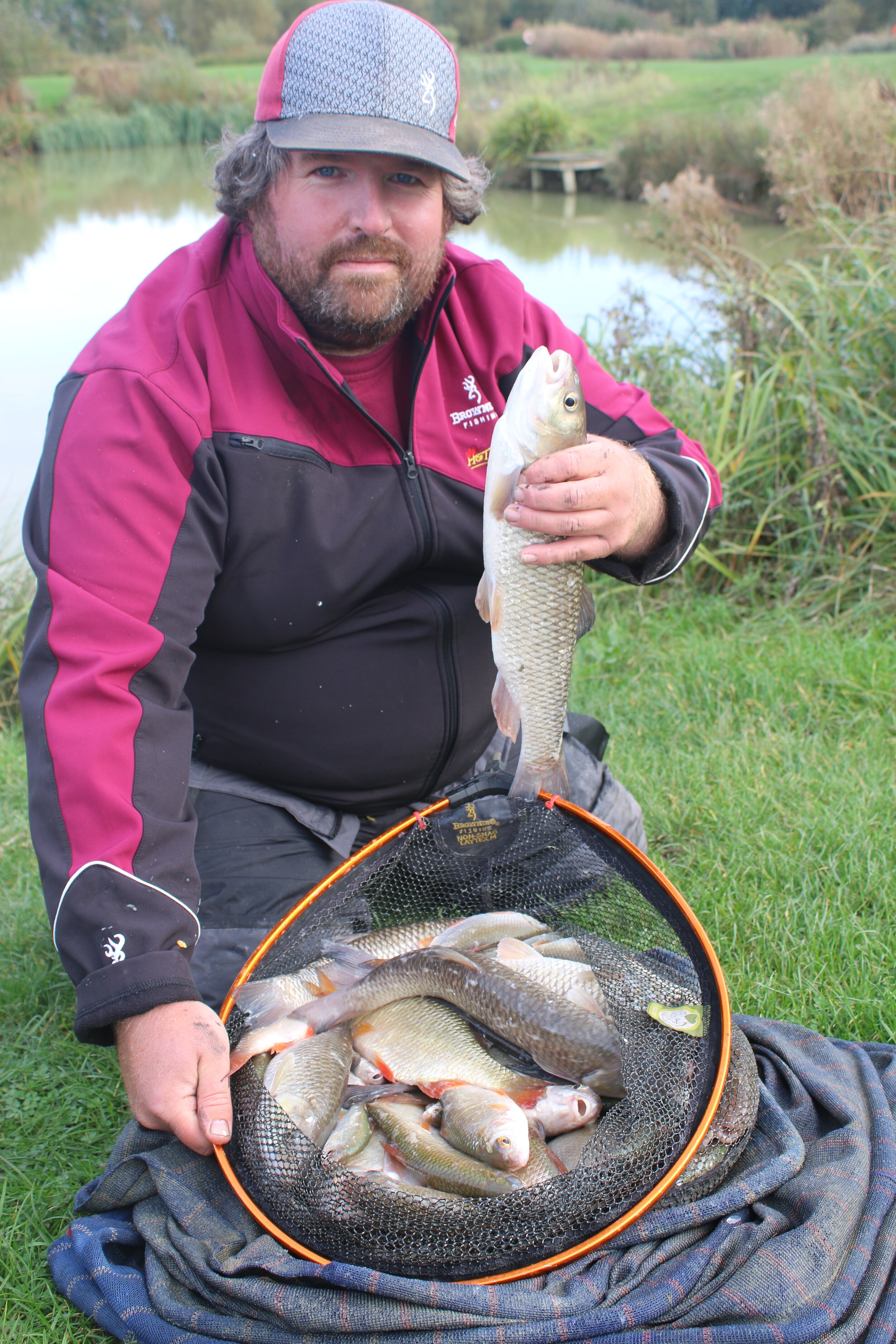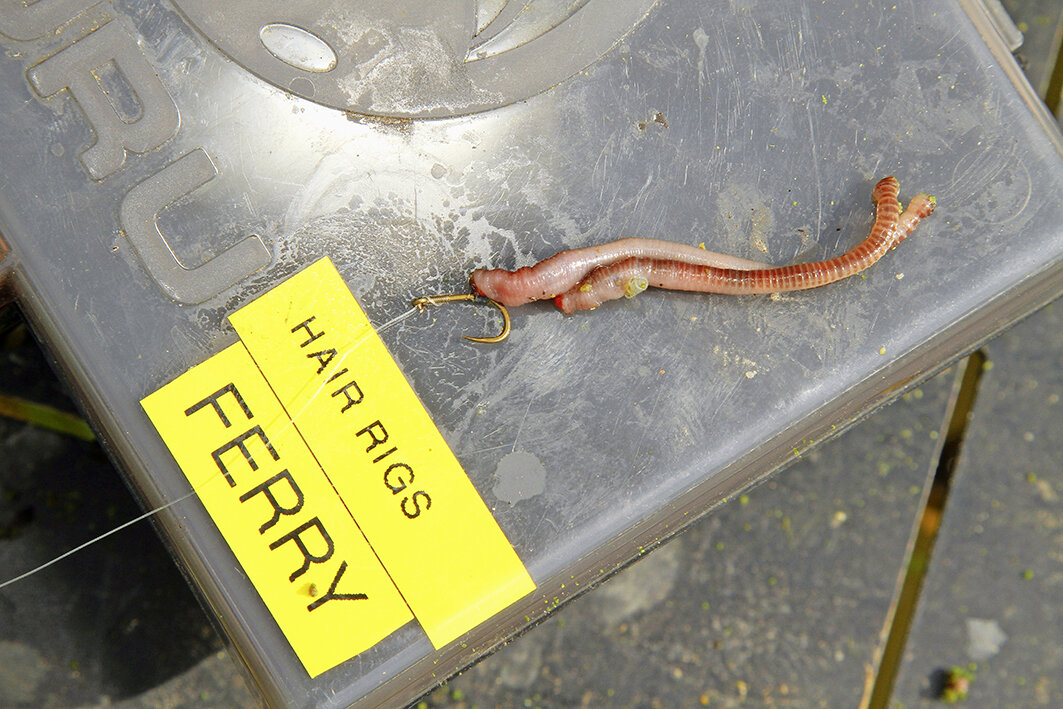Steve Ringer's 12 tips for the year ahead
Plot your way to the greatest year ever with Steve Ringer's month-by-month guide to his favourite tips and tactics.
January - Come closer to the bank to catch
The closer you fish, the faster you catch. I call this my ‘5m’ line but I often find myself fishing at around 6m-7m, and will plumb up to find a spot just over the nearside slope and on to the flat, deeper water where F1s feed with confidence in clear water. The beauty of this line is that you feed it all day but don’t tend to fish it until the last 90 minutes of the match… when you can double your catch!
The secret to making this line work, though, is the frequency of feeding. F1s are attracted into the swim by bait falling through the water, so kick off by feeding 4-6 maggots – you can up this to as many as 70-80 maggots later if there are loads of silverfish present! I feed by hand, which makes it a lot easier to keep the swim topped up when I’m fishing other lines.
February - Feed Micros for winter skimmers
Feeding loose micro pellets into deep water can be the kiss of death when you’re fishing for F1s and carp, leading to lots of line bites and foul-hooked fish – but for skimmers it can be brilliant! This is a method I picked up while fishing a silver fish match at Hayfield Lakes.
I’d been told that potting 2mm micro pellets worked well for the skimmers, but feeding loose micros into 10ft of water seemed like madness to me. Not catching much on my groundbait and pinkie approach, I decided to give it a go, and two feeds later I had a bite, then another and another. Within 20 minutes I was getting a bite every put-in. I can only think that the micros falling through the water were pulling fish into the swim. Since then this has been an approach I’ve used a lot.
March - Early bream, it's all about worms
In cold, coloured water there is no better bait for pulling bream into a swim than worms!
For a five-hour session I want to be using at least half-a-kilo of small dendrobaenas, and I will kick off by casting out six big cage feeders of my favourite 50/50 mix of Ringers Original Bag Up mix and Ringers Dark.
This is packed with as many very finely-chopped worms as possible, plus a sprinkling of micro pellets, casters and a few dead maggots.
This combination helps me introduce as much scent and attraction into the water as possible, in order to draw the fish to my hookbait.
This is usually two big pieces of hair-rigged worm – the perfect spring feed for bream!
April - Fish deep on the waggler
In the warmer weather fish start to move around looking for food. This is where searching the layers of the water can pay off. My favourite way of doing this is to fish a deep pellet waggler or, even better, a sinking float.
These ‘floats’ have a removable stopper. Add small shots to fine tune them so they sink slowly through the water column. On the waggler I start with a 5ft hooklength but will come shallower if I get indications.
The slow sinking float/bomb has a shorter 2ft 6inz hooklength. In an ideal world I will catch a few fish early on the waggler and then, if bites slow up, I will make the switch to the slow sinking bomb.
Bites are signified by watching the line where it enters the water or, when the carp are really on the feed, watching the rod-tip.
May - Go on the heavy hybrid
Once a Hybrid feeder hits the bottom it needs to be heavy enough not to move, otherwise the hookbait gets pulled away from the loose offerings. Feeder size determines the amount of bait you’re putting in and I use either Mini, Small or Large in various weights. When fishing in open water on small lakes, or when I only want to feed a small amount, a Mini in 24g is perfect.
The Small version is a more general-sized feeder for year-round use and comes in 24g and 36g weights. I pick the heavier version for longer casts. A ‘Big Bertha’ Large version, in 28g and 45g weights, allows you to get a lot more feed out and it’s the 45g size that I love for venues such as Boddington, where 90m-plus casts can be required.
June - Mug carp on the the mudline with meat
One of the most exciting tactics you can fish at this time of year is what I call ‘mud line’ fishing, where you fish across on snake lakes in literally inches of water, tight to the far-bank mud.
While it might not sound glamorous, it’s actually a very prolific approach and, if you get it right, quite often you can actually see the fish swirling in the shallow water as they take your bait.
It’s vital to find the right depth of water, and ideally you need 8ins-12ins tight against the bare bank in between areas of cover.
Baitwise there’s no better combo than 6mm meat cubes and wetted-down micros – the pellets give off loads of attraction, while the meat gives the fish a decent meal.
July - Lighter elastics are best for shallow fishing
When trying to catch big summer weights while fishing shallow, one of the best tricks is to go against the grain and use lighter elastics. This allows you to feed when playing fish and line up the next carp to be caught.
I use White Hydro, which is very soft and extremely forgiving, and when fished on a puller kit I can pretty much land anything on it, everything from a 1lb skimmer to a 10lb carp.
Being initially soft, it has the benefit of allowing me to lift into a fish and then, while the elastic is doing the work, I can feed the swim until the fish slows down and I can start to ship back.
The softness of White Hydro means the fish don’t splash all over the surface, something that can cause other fish in the swim to spook.
August - Clean up with a window feeder
Window feeders take some beating when you need to get a lot of particles into the swim. They are a vital part of my bream fishing at this time of year, especially when fishing at distance.
The weight on a window feeder is situated at the base so they cast like bullets and can still be fished accurately even at long range.
I tend to use the bigger sizes – they allow me to really attack the swim as they carry a lot of loose offerings.
There are lots of baits you can use in a window feeder, including casters, maggots and micros, but where I gain an edge in my bream fishing is to fill the feeder with chopped worms and give them a covering of groundbait to seal them in.
September - Use groundbait down the edge
Over the last few years groundbait and dead maggots have taken over as the best margin feed, but you need to find the right depth for it to work – between 10ins and 18ins is perfect!
If you are faced with deep margins then you’re better off using heavier baits that will stay on the bottom, such as corn or even big hard pellets.
I prefer a heavy coarse mix, and my favourite is Dynamite Sweet Fishmeal in the 2kg bag. I always like to slightly over-wet it, as I want to give the mix some weight so it will stay on the bottom.
As for feeding, it’s a case of really attacking the swim, and I will kick off with between eight and 10 large, 250ml pots of bait to try and hold the fish in the swim for as long as possible.
October - Go mini on the method
There are some really annoying swims in fishing – ones where there’s a fishy-looking far bank or island too far away for the pole.
This is when Mini Method feeders around the size of a £1 coin really come into their own – not only do they create minimal disturbance when cast into shallow swims, but they deliver a small mouthful of feed that’s ideal in the cooler conditions.
I use 2mm pellets as feed and fish a 6mm wafter hookbait on a size 14 QM1 hook.
As for colour, I will vary it a lot but as a guide, if the water is clear, I will look to kick off on a light, bright colour such as yellow or even white.
If your lake is holding a bit of colour then I’ve found a fluoro pink or even a pellet-coloured wafter is better.
November - Try a double wafter on the bomb
This trick has caught me a lot of fish recently. Instead of using hard pellets like everyone else, I’ve been fishing double wafters, and have been mixing the colours to create unique hookbaits.
Two wafters just sink when they’re attached to a size 10 QM1 hook, which means when a carp goes to suck the hookbait in it becomes very hard for it to eject it again, as it literally flies up inside its mouth.
While I’ve caught a lot of carp on two pellet wafters I’ve actually found that the washed-out yellows are a better bet.
I think the reason for this is that once in the water, two washed-out yellows look just like two coarse pellets that have been on the bottom a while and are viewed as being safe to eat.
December - Dig out the bread and get dobbing!
If you want to search your swim for carp in the cold then there’s no better tactic then dobbing bread discs on the pole.
Rush beds, overhanging trees and far-bank stick-ups are all obvious areas that are likely to hold fish and, as long as there’s around 2ft to 4ft of depth, they’re perfect places to explore with dobbed bread.
Most of my bread fishing is done with either an 8mm or 10mm sized piece of punch.
I will start on an 8mm and switch to a 10mm piece if I can’t get bites – the bigger the bait, the easier it is to spot!
Because you’re not feeding you need to really work the hookbait by lifting and dropping the float around 6ins clear of the water and then slowly lowering it back in again.
This causes the hookbait to rise and fall in the water, a movement that fish at times find irresistible, and bites tend to come just as the float settles.





















